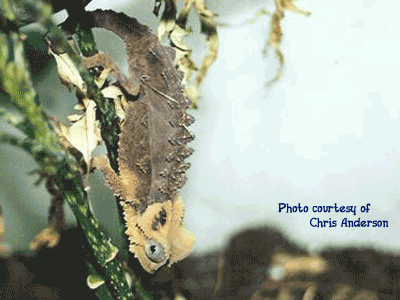



Questions and Answers
By Christopher V. Anderson
Citation:
Anderson, C.V. (2004). Questions and Answers. Chameleons! Online E-Zine, November 2004. (http://www.chameleonnews.com/04NovAndersonQA.html)
Q. Pooping in the Fish Bowl
I have had a male Veiled Chameleon for the last three months that is approximately six months old. He is kept on a screened in porch ten by twenty feet with screens on the south and west side. There are several hibiscus, ficus and a palm tree as vegetation. He spends most of his time on the Ficus tree which has a southern expouse with a reed screen that is fixed on the metal screen itself. What I am interested in is that this Veil has developed a routine of defecating on a two foot tall glass table that holds a few orchids and a one gallon fish bowl with aquatic plants. On several occasions he has defecated directly into the fish bowl. The table on which this happens is ten feet away from his usual haunt and requires his walking at least eight feet along the floor. Has anyone heard of a Veil or other genus defecating in a particular spot such as I have described, it do
A. Many animals often defecate outside of the area they typically inhabit during other periods. Often times, this requires the animal to travel short or long distances that they normally would not. Calumma parsonii is a species that is often considered very sedentary and during the winter months when they tend to become even more sedentary, they often experience their greatest periods of mobility to go and defecate away from the area they are typically perched. I have heard of keepers, who use containers in their enclosures to collect dripper water runoff, comment that their animals will often defecate in these containers of water. Other keepers who have experimented with waterfalls have noted this same behavior and it has become one reason waterfalls are not recommended in chameleon enclosures. As far as I am aware, however, the reason chameleons do this has not been determined completely. It is possible that by moving away from their typical territory to defecate or by defecating in the water, they are minimizing the chance that a predator will cue into a collection of fecal matter in their territory. For a predator, finding such a collection could indicate a meal and by defecating in the water or away from their territories, the chameleon could help prevent such predation threats. To answer your question directly, it isn’t an uncommon observation and there are a number of potential explanations for such behavior.
Q. Frogs as Food
I would like to have your opinion on feeding frogs to chameleons, would that cause any potential harm? I believe they would be a better source of calcium than most insect albeit a more complete meal.
Give me the green light and I'll throw some of those lil kermits into my chameleons' feeding bowl.
One of my worries is that some snakes seem to die after eating frogs, esp. chondros.
These frogs that I'm referring to are farm bred ones, not wild caught.
A. I can’t say that I have heard of any direct experience from anyone feeding frogs to chameleons but I’ll throw my 2 cents in none the less. I have never heard of any accounts of wild chameleons eating frogs. Considering the frog diversity in many of the areas chameleons occur, I tend to think they would not be a common meal, although possibly due to differing activity periods.
With the mucus that frogs secrete to keep their skin moist and the fact that many of these secretions can have irritating or toxic properties or cause unpleasant reactions, I would caution against using frogs as feeders. While some herps are known to eat frog and toads without problem, many others are known to have negative effects, like the chondros you mentioned, and I’d hate to have my animals be the ones to show chameleons having the same reaction.
Q. Poor Recovery after Oviposition and Birth
HI. My wife and I did a lot of research and purchased a female Jackson’s chameleon from a local pet store. She was very strong and vigorous and a joy to own. However. after having her for about 4 months. She slowed her eating and rested a lot more. I awoke one morning and found six still born babies and a very sick momma. We thought she was only 3 months old when we bought her. I rushed her to our Vet as soon as possible and was told she looked ok and was just tired. This proved untrue as she died the next day. I am only asking if you can provide any insight as to why she died due to her child birth. We kept her in a beautiful four foot high screen enclosure with lush foliage and waterfalls. We misted her three or four times daily and provided uv and heat lamps. her basking spot was kept at an average of 78 to 82 degrees with a humidity between 60 and 85 percent throughout the day.
Any clarity you can offer would be greatly appreciated.
A. Unfortunately, at this point there will be very little I will be able to do as far as determining a cause with any definitive accuracy. The best option would have been to have a necropsy complete with organ pathology done post mortem.
There are a number of possible causes for her death. You mentioned that you thought she was only 3 months old when you got her and there was no mention of you having a male so I’m assuming that she must have bred prior to you purchasing her. If she was bred at a young age and small size, it is very possible that the entire process of the pregnancy and birth was simply too large of a strain on her.
Another possibility is with regard to her origin. Many Ch. jacksonii are wild caught and sold as captive bred. If she was imported gravid, there is a good chance that this process was highly stressful and caused problems with the clutch. This would be especially likely if she was also housed in groups of chameleons during this process.
You didn’t mention anything about nutrition. It’s possible that in the lack of a properly gutloaded or supplemented diet, forming a clutch of babies could have taken a heavy toll on her that became too much after birth.
I noticed that you used a waterfall. These are generally not recommended for chameleons as they can be breeding grounds for bacteria and a potential source of upper respiratory infection. If she started coming down with a URI, it is all together possible that the stress off birth amplified the problem leading to her death.
Finally, it could be any combination of the above or many other reasons. Hopefully I’ve at least provided you with some information to think about. Good luck in the future!
Q. Pet Store Chameleons
I would like to ask in addition to my request to being placed on your mailing list: What can I ("we"-animal and chameleon enthusiasts) do to stop the neglect that these animals must suffer from by being put up for sale in pet shops which have no knowledge of how to care for them and sell them as novelty pets? I have seen many pet stores in a few different states that basically have no clue as to how to care for these animals and the special attention they require and then are sold to people without the proper information and supplies to care for them. I know that I cannot afford, nor do I have the room to adopt ALL the chameleons from ALL these places, so what can I do? It breaks my heart every time I see a chameleon in a glass 10 gallon fish tank with a water dish, and no proper lighting. If you have any suggestions, please let us know because I would like nothing more than to never see a sad living environment for these creatures again. Thank you.
A. I hate to say it, but most of the time, the best thing to do it simply leave the chameleon at the shop. If you purchase the animal, you will send the message that there is demand and it is sufficient enough that they can rely on a sale before their poor care kills the chameleon and they end up losing money. If they start losing money because they don’t sell, they will not want to stock them. Most shop owners, when approached about the poor care they are giving and the improper advice they give simply reply that the situation is only temporary until the chameleon is sold and that the advice they give is what they know. One can try to provide them with proper care advice but often this is met poorly.
Personally, if I find myself in a store caring for their animals poorly, I talk to the owner/manager and trying to be polite, talk to them about the mistakes they are making. If this doesn’t work, I don’t hesitate to tell individuals looking at the chameleons what type of condition they are in and how poorly they are being cared for.
Q. International Protection
Is anyone working w/Brookesia perarmata? Do you know where I could obtain a group?
A. Sorry to be the bearer of bad news but I tend to think you will have a difficult time finding any legal Brookesia perarmata. I loved working with this species and was fortunate enough to have a nice group for a number of years. Anyway, B. perarmata are now listed on appendix I of CITES. This means that there can be no exportation from Madagascar and all international trade is highly monitored. This species came out of Madagascar in large numbers for years but was never reliably bred in any large numbers. Furthermore, the majority didn’t seem to last long in captivity, although there were a few who maintained groups for a number of years at a time. While there might be some still floating around in the hands of a few collectors, the chances of legal specimens being sold in the future are grim and unlikely.


Christopher V. Anderson

Chris Anderson is a herpetologist currently working on his Ph.D. at the University of South Florida after receiving his B.S. from Cornell University. He has spent time in the jungles of South East Asia, among other areas, aiding in research for publication. He has previously traveled throughout Madagascar in search of, and conducting personal research on, the chameleons of the region. He has traveled to over 35 countries, including chameleon habitat in 6. Currently, Chris is the Editor and Webmaster of the Chameleons! Online E-Zine and is studying the kinematics and morphological basis of ballistic tongue projection and tongue retraction in chameleons for his dissertation. Chris Can be emailed at Chris.Anderson@chameleonnews.com or cvanders@mail.usf.edu.









Join Our Facebook Page for Updates on New Issues:
© 2002-2014 Chameleonnews.com All rights reserved.
Reproduction in whole or part expressly forbidden without permission from the publisher. For permission, please contact the editor at editor@chameleonnews.com
